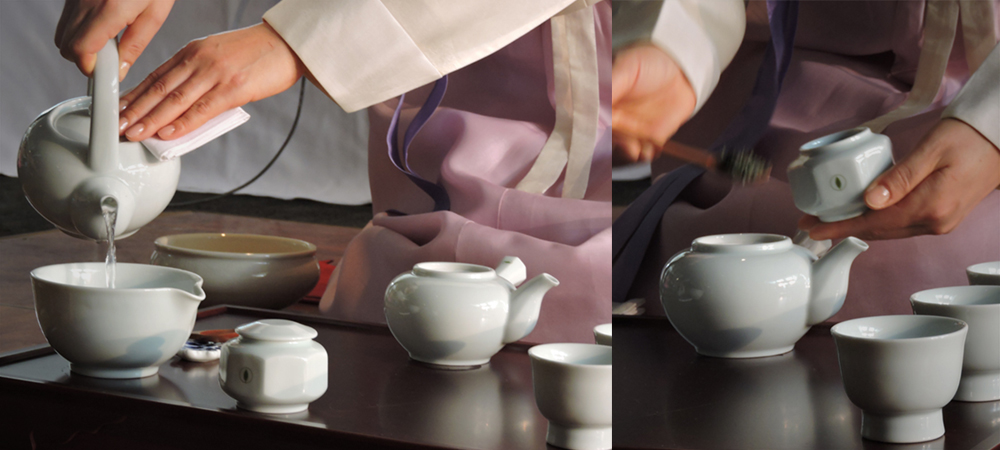Tea arrived in Korea from China in the early years of the Koryo dynasty (918-1392) via Buddhist monks, but it was not until the 1970s that it could boast its own definitive tea ceremony, Darye, which roughly translates to ‘day tea rite’ or ‘etiquette for tea’.
This is not to say Korea had been deprived of a tea making ceremony for centuries, but due to political (versus Japan) and cultural (versus Confucianism) upheaval, many of the older ways have been lost in time. In short, if you could sum up Korea’s relationship with the ritual of taking tea in a Facebook status, it would be ‘it’s complicated’.
We pick up the story of Darye, then, after the Korean War in 1953 with a man named Choi Beom-sul, who would eventually become known as Venerable Hyo-Dang. His mission was to re-establish a tea-drinking culture in Korea: firstly by re-discovering some of the lost arts in monasteries scattered around the country that had survived political and cultural disruption, and secondly by developing a written record of these practices.
The Korean Way of Tea, published in 1973, is Hyo-Dang’s legacy. The book details a method of tea brewing called Panyaro (‘dew of enlightening wisdom’), which is best described as Zen Buddhism for the everyday tea drinker. It is a ritual of purification and fortification and is designed to be performed in an environment where the tea maker and drinker can express gratitude and enjoy the ‘naturalness’ and simplicity of life through the preparation and drinking of the beverage.
Panyaro greatly informs the modern version of Darye, which a formalisation of this simple ritual. Darye not only holds sacred the Zen Buddhist ideal of simplicity, its deliberate and elegant choreography has been developed to relax the mind.
Ingredients for Darye
Equipment for the Korean tea ceremony is aesthetically simple, usually of neutral colours mimicking natural tones and made of earthenware or stoneware.
Darye is performed on a mat or low table covered with a linen tablecloth. Ceramic equipment includes a tagwan (teapot with a side handle), handleless cups, a cooling bowl, a bowl for wastewater, a teapot lid stand and a tea container, in addition to wooden tools such as coasters and tongs. Other items considered essential are a kettle, a cotton cloth and a serving table.
Importantly, the tea used in Darye is Korean green tea, also known as Panyaro tea. This tea was not widely grown in the Republic of Korea until the 1960s due to the loss of many of Korea’s tea plantations to Japan in the late 16th century. Hyo-Dang succeeded in his mission to revitalise the growth and production of tea in Korea, another reason modern Darye owes plenty to him.

The ritual of Darye
The host, usually dressed in hanbok, Korea’s national raiment, pours hot (not boiling) water from the kettle into the cooling bowl, then from the cooling bowl into the teapot. From the teapot, hot water goes into each of the cups to warm them.
The tea maker then pours hot water from the kettle into the cooling bowl again. Taking up the tongs, the host places four pinches of tea into the tagwan, then transfers the water from the cooling bowl into the teapot. Steeping time is generally 2-3 minutes.
After emptying the hot water from the teacups, the tea maker then pours a small tasting serve of tea for his or herself to ensure it is ready for guests to drink. When satisfied, s/he then pours the tea into the guests’ cups from the furthest cup toward her/his own, with a few seconds’ pause between each pour.
On this first round the host only fills each cup half-full, then works back until each cup is three-quarters full. This is to ensure that the taste is as even as possible because the tea is still steeping as the pouring continues.
Once ready, the guests’ cups are paired with a coaster and then placed on the serving table. The guest picks up both teacup and coaster, then takes three sips: one to enjoy the colour of the tea liquor, the second to appreciate the aroma and the third to savour the taste.
It would remiss not to note some similarities between the Korean tea ceremony and its better-known Japanese counterpart, Chanoyu, where each step of tea making is performed with reverent grace. But while both have Zen Buddhist roots, the Korean tea ceremony is deliberately simpler—performed by steeping tea leaves, not whisking matcha—and without the many formalities of Chanoyu such as the decoration of the room, the art on the teacup and the various bows the host and guests must perform in even the shortest ritual.
Decades after Hyo-Dang wrote his book of tea, the old art of Darye has gained a modern audience: busy Koreans who yearn for a simpler life. In this regard, it’s not just Koreans but tea drinkers from around the world who understand the power and simplicity of a cup of tea.
The featured banner is of a Darye ceremony at the 2015 Australian International Tea Expo. Photo by Adeline Teoh.

